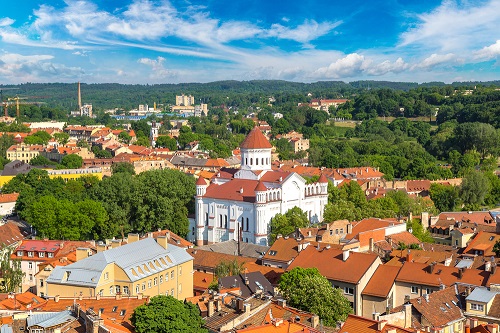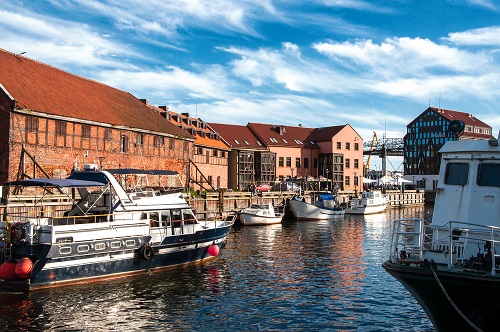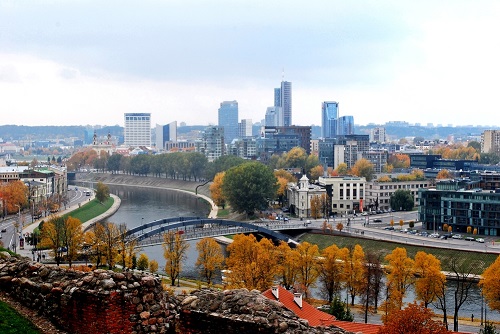How much you will pay for health procedures in Lithuania will depend on whether you access the public or the private healthcare sector. The public sector, if you are entitled to use it, is free at the point of delivery, with a few exceptions. However, you will obviously have to pay to use the private sector, either out of pocket or via your insurance. In practice, most expats resident in Lithuania tend to opt for private coverage, partly to avoid any issues in the public system, such as lengthy waiting times. We will look at some of your options below.
State health insurance costs in Lithuania
The WHO reports that health expenditure per capita in Lithuania (€1,406) is currently around half the EU average (€2,797). As a share of GDP, health spending has increased from 5.6% in 2005 to 6.5% in 2015, but it is still the sixth lowest in the EU.
Public healthcare in Lithuania is run by the Ministry of Health, which also runs a number of medical institutions, including teaching hospitals. The national insurance scheme, the CHIF, runs health insurance in Lithuania and operates on a principle of universal coverage. There are five territorial health insurance funds, covering Vilnius, Kaunas, Klaipėda, Šiauliai and Panevėžys.
Public healthcare is funded by mandatory health insurance contributions and the state. Your national health insurance contributions will be deducted from your salary and are currently set at 6.98% of your income. Around 55% of the population are funded by the state, including children under 18, old-age pensioners, and those who are disabled or unemployed.

If you are an EU national and are residing in Lithuania, you will be entitled to treatment under the national healthcare system, as a result of reciprocal healthcare agreements with your home nation. You will be able to use your EHIC. Card holders can apply for medical care directly from a GP that has an agreement with the Territorial Health Insurance Fund (THIF) or Teritorinė ligonių kasa.
If you are an expat from another country and are resident in Lithuania, and you are paying national insurance contributions into the CHIF, you will also be eligible for public healthcare. This will be free at the point of delivery, with the exception of some prescription charges. These have historically been quite high, thus limiting patient access to medication, and the government has attempted to address this recently.
You will be able to access healthcare services provided in private, public, and municipal healthcare institutions if you are not insured under the national scheme, but you will have to pay. Costs can quickly escalate, so it is advisable to have some form of insurance.
The World Health Organisation (WHO) reports that the public health system in Lithuania is heavily reliant on out-of-pocket payments. In 2015, they relate, out-of-pocket payments accounted for 32% of total spending on health. This is well above the European Union average of 22% and is partly due to a fall in public spending on health in the years following the economic crash of 2008.
As we note above, entitlement to CHIF benefits is linked to payment of contributions rather than to residence, but this leaves around 6% to 10% of the population without coverage for non-emergency care. Those who fall under the CHIF benefit from free access to doctors and hospitals, but there are significant gaps in coverage for outpatient medicines and dental care.
The WHO notes that voluntary health insurance does not cover these gaps among Lithuanians, as it is purchased by less than 1% of the population – mainly higher-paid employees. Expats are in a somewhat different position, as a much higher percentage can afford private cover.
How much does treatment cost in the private sector?
Dental treatment is not covered by national health insurance, and you will therefore need to take out a private dental plan or pay out of pocket. Costs, however, are significantly lower than elsewhere in Western Europe or the USA.

Some sample costs include:
- Consultation: €15
- Anaesthesia: €10
- Dental X-ray: €8
- Panoramic X-ray: €30
- Composite filling: €50 to €70, depending on size of filling
- Titanium tooth implant: €580
- Metal ceramic crowns: €220
- Temporary crown: €40
- Complete single jaw denture: €360
- Dental treatment for children: €20 to €60
The private sector also offers a wide range of cosmetic procedures. Due to competitive pricing and a high standard of treatment in the private healthcare sector, Lithuania is becoming a destination for medical tourism. Procedures on offer include:
- Breast augmentation: €2630
- Breast reduction: €1902
- Breast uplift: €1902
- Tummy tuck: €1902
- Buttock implants: €3021
- Arm lift: €1902
- Thigh lift: €1902
- Liposuction: €1231
- Facelift: €3525
- Brow lift: €1902
- Eye bag removal: €615
- Botox (one area): €100
- Botox (two areas): €201
- Botox (three areas): €302
You may need to check with your insurer whether you need pre-approval for cosmetic surgical procedures under your existing policy. You will also need to ask your selected clinic what their preferred method of payment is and whether they will accept your insurance. Do not be afraid to ask about qualifications, references and testimonials, and word of mouth recommendations are often helpful.

